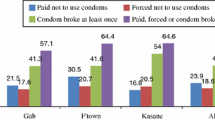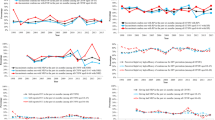Abstract
Little is known about sex work in Tashkent, Uzbekistan, despite rapid increases in HIV infection. Consistent client condom use and prior HIV testing are described among 448 female sex workers (FSW) completing a self-administered questionnaire, health provider interview, and HIV testing between April 2003 and March 2004. Participants were recruited through outreach workers using modified snowball sampling. Consistent client condom use was more likely for FSW who were married, knew condoms prevent HIV, and from countries in south Central Asia. Prior HIV testing was less likely for FSW younger than 21 years, who shared drugs with clients, initiated sex work at 18 years or less and had engaged in sex work less than 2 years. Low rates of condom use, particularly by those with risky drug behaviors, indicate that targeted risk-reduction interventions are urgently needed.
Similar content being viewed by others
References
Aral, S. O., & St Lawrence, J. S. (2002). The ecology of sex work and drug use in Saratov Oblast, Russia. Sexually Transmitted Diseases, 29, 798–805.
Aral, S. O., St Lawrence, J. S., Tikhonova, L., Safarova, E., Parker, K. A., & Shakarishvili, A., et al. (2003). The social organization of commercial sex work in Moscow, Russia. Sexually Transmitted Diseases, 30, 39–45.
Aral, S. O., St Lawrence, J. S., Dyatlov, R., & Kozlov, A. (2005). Commercial sex work, drug use, and sexually transmitted infections in St. Petersburg, Russia. Social Science & Medicine, 60, 2181–2190.
Benotsch, E. G., Somlai, A. M., Pinkerton, S. D., Kelly, J. A., Ostrovski, D., & Gore-Felton C., et al. (2004). Drug use and sexual risk behaviours among female Russian IDUs who exchange sex for money or drugs. International Journal of STD & AIDS, 15, 343–347.
Buckley, C., Barrett, J., & Asminkin, Y. P. (2004). Reproductive and sexual health among young adults in Uzbekistan. Studies in Family Planning, 35, 1–14.
Dehne, K. L., Pokrovskiy, V., Kobyshcha, Y., & Schwartlander, B. (2000). Update on the epidemics of HIV and other sexually transmitted infections in the newly independent states of the former Soviet Union. AIDS, 14(Suppl 3), S75–84.
Grayman, J. H., Nhan do, T., Huong, P. T., Jenkins, R. A., Carey, J. W., West, G. R., et al. (2005). Factors associated with HIV testing, condom use, and sexually transmitted infections among female sex workers in Nha Trang, Vietnam. AIDS & Behavior, 9, 41–51.
Kurmanova, G. (2003). Current situation in the area of sex work in Tashkent City, Republic of Uzbekistan. Report on the results of Rapid Assessment; Tashkent, November 9–15, 2003, Technical Report, Tashkent: UNAIDS Uzbekistan Office.
Kyrychenko, P., & Polonets, V. (2005). High HIV risk profile among female commercial sex workers in Vinnitsa, Ukraine. Sexually Transmitted Infections, 81, 187–188.
Morisky, D. E., Ang, A., & Sneed, C. D. (2002). Validating the effects of social desirability on self-reported condom use behavior among commercial sex workers. AIDS Education and Prevention, 14, 351–360.
Nurgazieva, J. (1999). Kyrgyzstan: STD management during the syphilis outbreak. Entre Nous (Copenhagen, Denmark), 42, 13.
Oostvogels, R. (2001). Assessment of female sex workers and clients in Tashkent, Republic of Uzbekistan, Technical Report, Tashkent: UNAIDS Uzbekistan Office.
Persaud, N. E., Klaskala, W. I., Baum, M. K., & Duncan, R. C. (2000). Sexually transmitted infections, drug use, and risky sex among female sex workers in Guyana. Sexually Transmitted Infections, 76, 318.
Rojanapithayakorn, W., & Hanenberg, R. (1996). The 100% condom program in Thailand. AIDS, 10, 1–7.
Slaymaker, E., & Zaba, B. (2003). Measurement of condom use as a risk factor for HIV infection. Reproductive Health Matters, 11, 174–84.
Thomas, R. M. (1997). Assessment of the commercial sex work scene in Tashkent, Uzbekistan, Technical Report, Tashkent: UNAIDS Uzbekistan Office.
Todd, C. S., Khakimov, M. M., Alibayeva, G., Abdullaeva, M., Giyasova, G. M., & Saad, M. D. et al. (2006) Prevalence and correlates of human immunodeficiency virus infection among female sex workers in Tashkent, Uzbekistan. Sexually Transmitted Diseases, 33, 496–501.
United Nations Development Programme (UNDP). (2004). HIV/AIDS in Eastern Europe and the Commonwealth of Independent States: Reversing the epidemic, Facts and Policy options. Technical Report, Bratislava, Slovak Republic: UNDP Office.
UNAIDS (2005). AIDS epidemic update. Technical Report, Geneva: Joint United National Program on HIV/AIDS.
United Nations Childrens Fund (UNICEF) (2005). Uzbekistan: Statistics. Retrieved December 6, 2005, from http://www.unicef.org/infobycountry/uzbekistan statistics.html#4.
Weir, S. S., Roddy, R. E., Zekeng, L., & Ryan, K. A. (1999). Association between condom use and HIV infection: a randomised study of self reported condom use measures. Journal of Epidemiology and Community Health, 53, 417–422.
Yadav, G., Saskin, R., Ngugi, E., Kimani, J., Keli, F., & Fonck, K., et al. (2005). Associations of sexual risk taking among Kenyan female sex workers after enrollment in an HIV-1 prevention trial. Journal of Acquired Immune Deficiency Syndrome, 38, 329–334.
Acknowledgments
This study was supported by the US Military HIV Research Program (USMHRP) at the Walter Reed Army Institute of Research (WRAIR), and by the US Naval Medical Research Center (NMRC), Silver Spring, MD (Work Unit Number 62787–873-HE0001). We would like to thank Dr. Adkham Mamatkulov and Mr. Ilkhom Kasymov for assistance in coordinating the study. We would also like to acknowledge Ms. Oksana Subotova for translation and database entry assistance. Finally, we would like to thank the participants for their time and trust. Disclaimer: The opinions and assertions made by the authors do not reflect the official position or opinion of the US Department of the Navy or Army, of the Henry M. Jackson Foundation for the Advancement of Military Medicine, Inc., or of the respective in-country National HIV/AIDS Control Programs and other non-governmental organizations (NGOs).
Author information
Authors and Affiliations
Corresponding author
Rights and permissions
About this article
Cite this article
Todd, C.S., Alibayeva, G., Khakimov, M.M. et al. Prevalence and Correlates of Condom Use and HIV Testing Among Female Sex Workers in Tashkent, Uzbekistan: Implications for HIV Transmission. AIDS Behav 11, 435–442 (2007). https://doi.org/10.1007/s10461-006-9155-x
Published:
Issue Date:
DOI: https://doi.org/10.1007/s10461-006-9155-x




